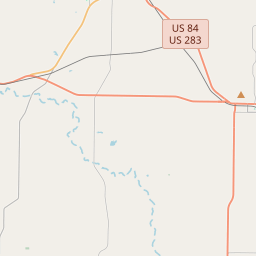Santa Anna, C.S.A.
Historical marker location:






Mountain and town named in honor of man in power here in 1840's, a Comanche chief friendly to Texans. Santa Anna in 1846 visited President Polk in Washington during U.S. negotiations to annex Texas. Also signed and kept until his death of cholera in 1849 peace treaties that allowed the German Emigration Company to settle lands north of the Llano River. Comanches used Santa Anna peaks as signal points. Early surveyors, travelers, explorers and settlers took them as guide points. In 1857, nearby United States Cavalry at Camp Colorado kept lookouts here. In the Civil War, 1861-65, frontier kept lookouts here. At foot of mountain, with sentries on heights watching at the pass the military road from San Antonio northeastward to Fort Belknap, a strategic outpost guarding Texas from invasion by Indians and Federal troops. During the 1870's thousands of longhorns went through the gap, over the western cattle trail. In 1879, "The Gap" had a store and post office to supply the cattle drives. When Gulf, Colorado and Santa Fe built here in 1886, settlers moved from The Gap to the railroad, starting the present town. Quarries in the mountain yield fine sands for the manufacturing of glass. (1965)
April 12, 1861: The Civil War begins with the Confederate attack on Fort Sumter, located in South Carolina's Charleston Harbor.
April 15, 1861: President Abraham Lincoln issues a call for 75,000 volunteers to serve in the Union Army to suppress the rebellion.
May 24, 1861: The first major land battle, known as the First Battle of Bull Run (or First Battle of Manassas), takes place in Virginia. It ends in Confederate victory.
September 17, 1862: The Battle of Antietam in Maryland becomes the bloodiest single-day battle in American history, with heavy casualties on both sides. The Union forces, commanded by General George McClellan, manage to halt Confederate General Robert E. Lee's advance into Union territory.
January 1, 1863: President Lincoln issues the Emancipation Proclamation, declaring that all slaves in Confederate-held territories are to be set free. However, the proclamation does not immediately free all slaves in the United States.
July 1-3, 1863: The Battle of Gettysburg in Pennsylvania takes place, resulting in a significant Union victory and inflicting heavy casualties on Confederate forces. It marks a turning point in the war.
November 19, 1863: President Lincoln delivers the Gettysburg Address, emphasizing the principles of liberty, equality, and the preservation of the Union.
April 9, 1865: General Robert E. Lee surrenders to Union General Ulysses S. Grant at Appomattox Court House in Virginia, effectively ending the Civil War.
April 14, 1865: President Lincoln is assassinated by John Wilkes Booth while attending a play at Ford's Theatre in Washington, D.C.
May 10, 1865: Confederate President Jefferson Davis is captured, signaling the collapse of the Confederate government.
December 6, 1865: The Thirteenth Amendment to the United States Constitution is ratified, officially abolishing slavery throughout the country.
While this timeline provides an overview of key events, it is important to note that the Civil War spanned over four years, from 1861 to 1865, and encompassed numerous battles, campaigns, and political developments that shaped the course of American history.
As one of the most visible programs of the Texas Historical Commission (THC), historical markers commemorate diverse topics in Texas history, including: the history and architecture of houses, commercial and public buildings, religious congregations, and military sites; events that changed the course of local and state history; and individuals who have made lasting contributions to the state, community organizations, and businesses.
The state flower of Texas is the bluebonnet. The flower blooms in the spring and is a common sight along the highways and in fields throughout the state.
In 1856, the Texas legislature created Coleman County, naming it after Robert M. Coleman, a signer of the Texas Declaration of Independence. The county was officially organized in 1864, and the town of Santa Anna was designated as the county seat. However, the arrival of the railroad in 1886 led to the development of the town of Coleman, which ultimately became the principal city and county seat.
During the late 19th and early 20th centuries, Coleman County experienced significant growth and prosperity. Cotton became a major cash crop, and ranching also played a crucial role in the local economy. The county's population grew, and new businesses and institutions, including schools and churches, were established.
Coleman County faced challenges as well, including periods of drought and the Great Depression of the 1930s. However, the local community persevered, and the county continued to develop over the years. Today, Coleman County remains an important agricultural and ranching center, while also embracing tourism and outdoor recreational activities as additional economic drivers. The county's rich history is commemorated through various historical sites and events, showcasing the enduring spirit of the community and its unique heritage.
Coleman County Timeline
This timeline provides a concise overview of the key events in the history of Coleman County, Texas.
- 1858 - Coleman County is established by the Texas legislature.
- 1876 - The town of Coleman is founded as the county seat.
- 1886 - The Santa Fe Railroad reaches Coleman, boosting the local economy.
- 1896 - Coleman County Courthouse, a significant historical landmark, is constructed.
- 1930-1939 - The Great Depression leads to economic challenges for Coleman County.
- 1940s-1950s - Coleman County experiences an increased interest in oil and gas exploration.
- 1986 - The Texas Railroad Commission names Coleman County the "Texas Top Oil Producing County".
- 1992 - A tornado causes significant damage in Coleman, resulting in the rebuilding of several structures.
- Present - Coleman County remains a vibrant community with a mix of agriculture, oil and gas, and tourism.